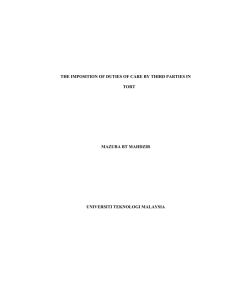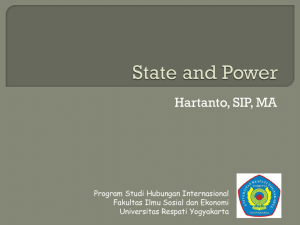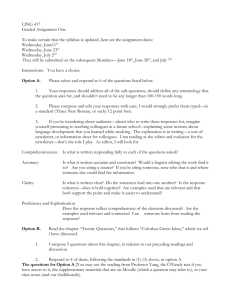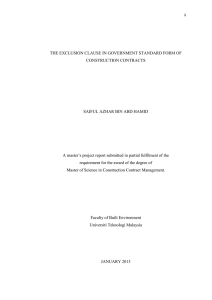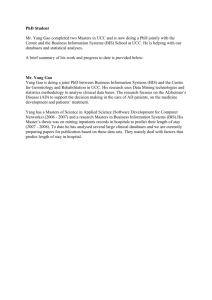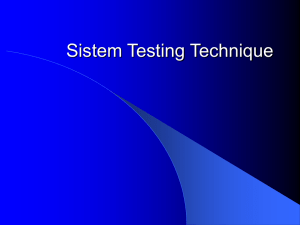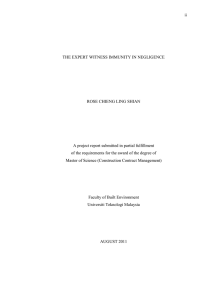conflict resolution dce3712 - UPM EduTrain Interactive Learning
advertisement
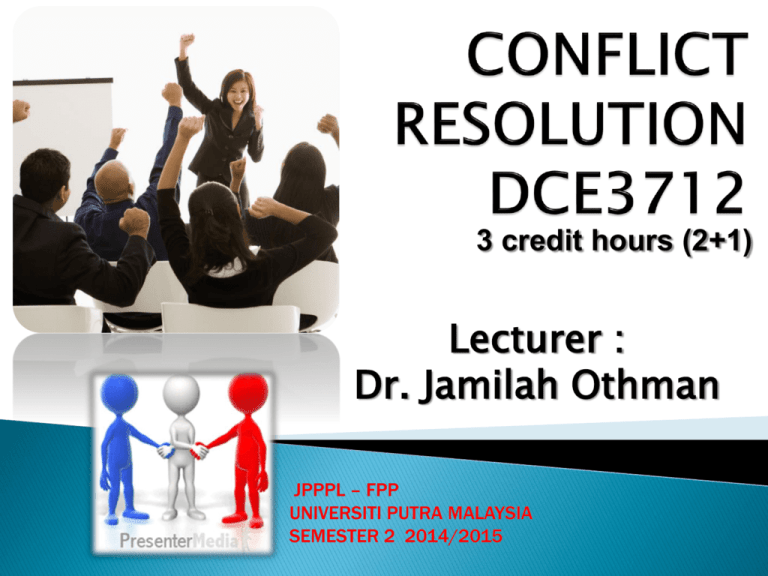
3 credit hours (2+1) Lecturer : Dr. Jamilah Othman JPPPL – FPP UNIVERSITI PUTRA MALAYSIA SEMESTER 2 2014/2015 Telephone : 03- 8946 8233 e-mail : jamilah.othman@gmail.com Semester : Semester Kedua 2014/2015 At the end of this course, student will be able to: ◦ Understand concepts and theories of coflict. (C4) ◦ Describe, analyze and evaluate situations of conflict at various contexts.(C6) ◦ Harness their skills in handling conflict. (A5) This Course Covers Basic Concepts And Theories Of Conflict, Sources And Effects Of Conflict, Types Of Conflict, Strategies For Conflict Resolution, Application Of Conflict Resolution In Human Resource Development, And Current Issues In Conflict. Concept and Theories of Conflict Views Of Conflict Context And Level Of Conflict Theories Of Conflict Management Types Of Conflict Intrapersonal Interpersonal Intergroup Intragroup International Factors Related To Conflict ◦ Control Over Resources ◦ Preferences And Nuisances (Priorities And Disturbances) ◦ Values ◦ Beliefs ◦ The Nature Of The Relationship Of The Conflicting Parties Methods Of Handling Conflict ◦ ◦ ◦ ◦ ◦ Competition & Cooperation Conflict Handling Styles Third-Party Roles Negotiation Mediation Outcomes Of Conflict Positive Outcome Of Conflict Negative Outcome Of Conflict Skills Required In Handling Conflict Identifying Conflict Situations Communication Stress Management Anger Management Problem Solving Issues In Conflict Management ◦ Human Rights ◦ Violence ◦ Stereotype And Generalizations Conflict Case Studies ◦ ◦ ◦ ◦ ◦ Interpersonal Conflict Family Conflict Organizational Conflict Community Conflict International/Interstate Conflict Conflict is a fact of life Conflict is a universal phenomenon Conflict is a perception issue Conflict happens as a result of individual’s perception of a phenomenon Conflict is a sharp disagreement or opposition of interest or idea A conflict exist whenever incompatibality occurs The Outcome of Conflict Can be Negative or Positive Conflict accurs when an individual or group feels negatively affected by another individual or group The Views About Conflict The Functionalist View The belief that conflict is harmful and must be avoided. The Human Relationship View The belief that conflict is a natural and inevitable outcome in any group or relationship. The Interactionist View The belief that conflict is not only a positive force in a group, but that it is absolutely necessary for a group to perform effectively. The Structuralist View The belief that there is always an underlying structural conflict between the producers of economic wealth and those who benefit most from the economic system. Deutch (1973) A conflict exists whenever incompatible activities occur. Tjosvold & Johnson(1989) Conflict is not to be avoided or eliminated, but managed. Jamilah, Rahim & Aminah (2006) Conflict happens as a result of individual’s perception of a phenomenon, whereby the phenomenon itself is presented as an obstacle to the individuals. Intrapersonal - conflict within the individual, the conflict is internal to the individual or inside oneself, - make decisions over choices - face dilemma when decision is difficult (eg.) role conflict Interpersonal - Conflict between individuals - Individuals can be within the same team or outside the team (eg) Conflict between one employee with another employee of the same department, conflict between siblings Intragroup - Conflict within a team or group - Conflict between members of a team or group (eg) Conflict between members of family, organization, football team, etc. Intergroup - Conflict between two or more teams or groups (eg) conflict between families, departments, organizations, countries, communities culture, religious groups etc. A theory is a means of explaining how something works The focus of a theory’s explanation directs attentions to that part of the conflict and assigns the underlying explanation on the cause of conflict 1.Psychodynamic and Attribution Theories - The way people act in conflict is due to the individuals ways of thinking a. Psychodynamic Theory - based on psychological theories by Sigmund Freud - people experience conflict because of their intrapersonal state - it explains how individuals respond to conflict situations, particularly in light of their aggressive impulses and their anxieties - the theory points out that people are not always aware of their motivations that drive their behavior - non-substaintive conflict (to release tension unrelated to the other person in the conflict situation) - misplased or displased conflict (conflict is acted out with the wrong person over the wrong issue) b. Attribution Theory - An individual makes conclusions about the other person’s behavior - Conclusions about the other individual are based on attributes about that individual or on inferences about the meanings, causes, or outcomes of conflict. - an attribution affects the way individual define conflicts, interpret the other’s behavior, and choose strategies to achieve their goals effectively within conflict situations. - individual conceptualize conflict and attribute it to various causes. - the perception of conflict arises when an individual feels frustration, thinks about the cause, and acts in response to it 2. Relationship Theories - focus on how relationships between people involved in a conflict is enacted and resolved a. Social Exchange Theory - people evaluate their interpersonal relationships in terms of their value created by the costs and rewards associated with the relationship. - the cost is the feelings on the assessment on the amount of effort put into the relationship - the rewards is what is received as a result of the relationship - the theory assumes that people choose their behaviors due to self-interest and a desire to maximize rewards and minimize costs. - conflict arises when one person in the relationship feels that the outcomes are too low and perceive that the other will resist any attempt to raise the outcome. b. Game Theory - people act in conflict situations from a position of self-interest, and that moves and couter moves are chosen to maximize rewards and minimize costs. - interdependent actions and estimations of moves and countermoves within a conflict situation affect the movement of a conflict toward resolution. c. Systems Theory - it assumes that conflict represents a breakdown in communication from the normal, harmonious state of affairs. - it also assumes that conflict as a normal part of interaction. - sees conflict as an important part of a system - allows change and adaptation to various demands. 3. Structural Theory - The struggle between social factions (groups of different beliefs and values) - These factions may co-exist peacefully although basically they may be hostile to each other a. Marxism and Capitalism - structural conflict that exist due to control of the production and distribution of wealth in a society - sometimes it takes the form of religious struggle but it strongly points to political and economic struggle - each conflicting party tries to get control of the people to gain power by trying to get control of the ideology of the mass - in capitalist system the conflict is between those who have the control production and distribution of wealth and those who sell their ability to work in the capitalist system b. Radical Feminism - ‘radical’ means looking at the root cause - the two conflicting factions are women and men - the achievements of women were hidden when men were usually the winners in the conflict between men and women. woman without her man is nothing Type of Conflict Constructive Conflict Supports Organization Goal Increases Organization Achievement Increases Organization Image E.g : ISO, or Introduction of any innovations Destructive Conflict Does Not Support Organization’s Goal Decreases Organization’s Achievement Decreases Organization’s Image E.g : Sexual Harassment Intra-personal Within an individual Inter-personal Between two or more individuals Intra-group Within a group Inter-group Between two or more groups Positive Outcome of Conflict Binds people together Preserves a relationship Helps to define and clarify structure and expectations Better Decision Increases Productivity Leads to new growths and ideas Energizes and Increases Peoples’ Motivation Negative Outcome of Conflict Decreases Satisfaction Decreases Teamwork Increases Turnover Sabotage and Abuse Conclusion Views of conflict differ among individuals. Conflict can be constructive or destructive. Outcomes of conflict can be positive or negative. Contents The Cause of Conflict Individual’s Conceptualization Hierarchy of Needs Variables Affecting The Cause of Conflict The Conflict Process Stages of Conflict Process Conclusion ◦ Control Over Resources ◦ Preferences and Nuisances E.g : music while working, technology ◦ Values E.g : value judgment ◦ Beliefs E.g : Organization mission and vision ◦ The Nature of The Relationship E.g : siblings Internal / personal / developmental factors Steps in the process of conceptualization External factors Level of. Development Process of conceptualization State of the individual. Value / need set Content Stimulus experience symbolization Causal attribution Intentional attribution Context analysis Content analysis Choice assessment Context Selfactualization Esteem Social Safety Physiological Physiological Hunger, thirst, shelter, sex, and other bodily needs Safety Security and Protection from Physical and Emotional Harm Social Affection, belongingness, acceptance and friendship Esteem Internal esteem factors such as self-respect, autonomy and achievement External esteem factors such as status, recognition and attention Self-actualization The drive to become what one is capable of becoming, includes growth, achieving one’s potential and self-fulfillment The characteristics of the parties in conflict Their prior relationship to one another The nature of the issue giving rise to the conflict The social environment within which the conflict occurs The interested audiences to the conflict The strategy and tactics employed by the parties in the conflict The consequences of the conflict to each of the participants and to other interested parties Five stages of the conflict process model: Stage Stage Stage Stage Stage 1 2 3 4 5 : : : : : Potential for conflict Recognition of conflict Conflict handling styles Conflict behavior Conflict outcomes Stage 5 Stage 2 Potential for conflict Recognition of conflict Conflict handling style Conflict behavior Conflict outcomes Perceived Competing Overt conflict:- Increase group performance Preceding circumstance : conflict Stage 3 Stage 4 Stage 1 Collaborating - communication behavior Compromising - structure - personal variables - party’s Felt Avoiding conflict Accommodating - other’s behavior Decrease group performance Conclusion Individual perception and view on issues influence the cause of conflict. Individual’s needs and interests are important to be considered in understanding issues of conflict. Contents Five Common Conflict Styles Model SALAM Third-Party Roles Model Thomas Kilmann Avoiding Accommodation Competing Compromising Collaborating Tinggi Bertanding Bergabung (compete) (Collaborate) Berkompromi (Compromise) Pengelakan (Avoid) Rendah Akomodasi (Accommodate) Tinggi S = starting the conflicting view A = agreeing that a conflict exist L = listening for and learning the difference A = advising one another (menjelaskan isu konflik) M = minimizing area of disagreement that could lead to aggression or withdraw Mediator(Mediasi) Arbitrator (Penimbang Tara) Conciliator (Pendamai) Consultant (Pakar Runding) Mediator (Mediasi): Pihak ketiga yang neutral Membantu proses membuat keputusan oleh pihak yang berkonflik Tidak memihak kepada mana-mana pihak yang berkonflik Arbitrator (Penimbang Tara) Pihak ketiga yang berkuasa untuk membuat keputusan untuk mereka yang berkonflik selepas memdengar kedua-dua pihak Conciliator (Pendamai): Pihak ketiga yang mewujudkan jalinan komunikasi kepada mereka yang berkonflik. Menggalakkan mereka yang berkonflik untuk mencapai persetujuan Consultant (Perunding): Pihak ketiga yang menjadi pakar runding untuk membimbing mereka yang berkonflik untuk memcapai persetujuan.
